THE NEWS-WORTH CANVAS: The ultimate tool to create newsworthy stories
I am one of those people who grew up having no idea about what they wanted to be when they grew up. And so my journey to thinking about business and creating products has taken a circuitous path. I studied a lot of things at university without ever settling for a line of work.
After several years of intensive marketing work in my own startups, combined with my academic knowledge in Journalism and Psychology, I began understanding what really drives people's attention. That is what we call News-Worth Dynamics. Understanding News-Worth Dynamics provided me a clear framework for creating products that people would care about and that organically get into media outlets without too much effort.
Thanks to the application of journalism and mass media frameworks to business development, I was able to test and grow my startups quicker than anyone would think is possible. Instead of focusing on profitability or solving problems, I was more focused on creating something that people would care about. So I kept asking myself: what is the element of this idea that makes it newsworthy? In other words: where is the Dinosaur?
Understanding News-Worth Dynamics is particularly useful at the early stages of a new project. Thinking about your project in terms of a story that people care about really gets you thinking about the right things. It forces you to build something that is connected to what people are interested in. It forces you to create something that is easy to explain even to the most uninformed person. That is why Jeff Bezos demands his teams at Amazon to come up with a press release before even considering to develop something new. It forces them to reflect on the project in terms of what people buy, not in terms of what they are selling.
The main idea behind News-Worth Dynamics is that all stories need to have something to make them newsworthy. Not all information is newsworthy. Stories need to supply certain elements of interest to qualify as news. These elements of interest conform the Seven Traits of News-Worth.
The Seven Traits of News-Worth are taught in journalism schools all over the world and they are used in every media outlet to separate news from noise. In other words, journalists decide what gets published and what remains unread by looking at the Seven Traits of News-Worth. For something to be newsworthy, it must be:
- 🏠 Close to home
- 📍 Geographically close
- 💬 Thematically close
- ❤️ Emotionally close
- ⏱ Current
- 👨👩👧👦 Have broad impact
- 🤯 Unexpected or bizarre
- 👸 Involve relevant people
- ✊ Cause struggle or conflict
- 🗣 Have previous media coverage
With the Seven Traits of News-Worth in mind, and after years of trial and error, we have created a handy tool that we call the News-Worth Canvas. The News-Worth Canvas has seven modules, one module for each trait of news-worth. This tool resembles a painter's canvas and allows you to draw on seven connected boxes.
The News-Worth Canvas will help you and your team to brainstorm and develop newsworthy stories that make your project organically viral. It will allow you to explore the nooks and crannies of your bright mind so as to master all the elements that make a project newsworthy.
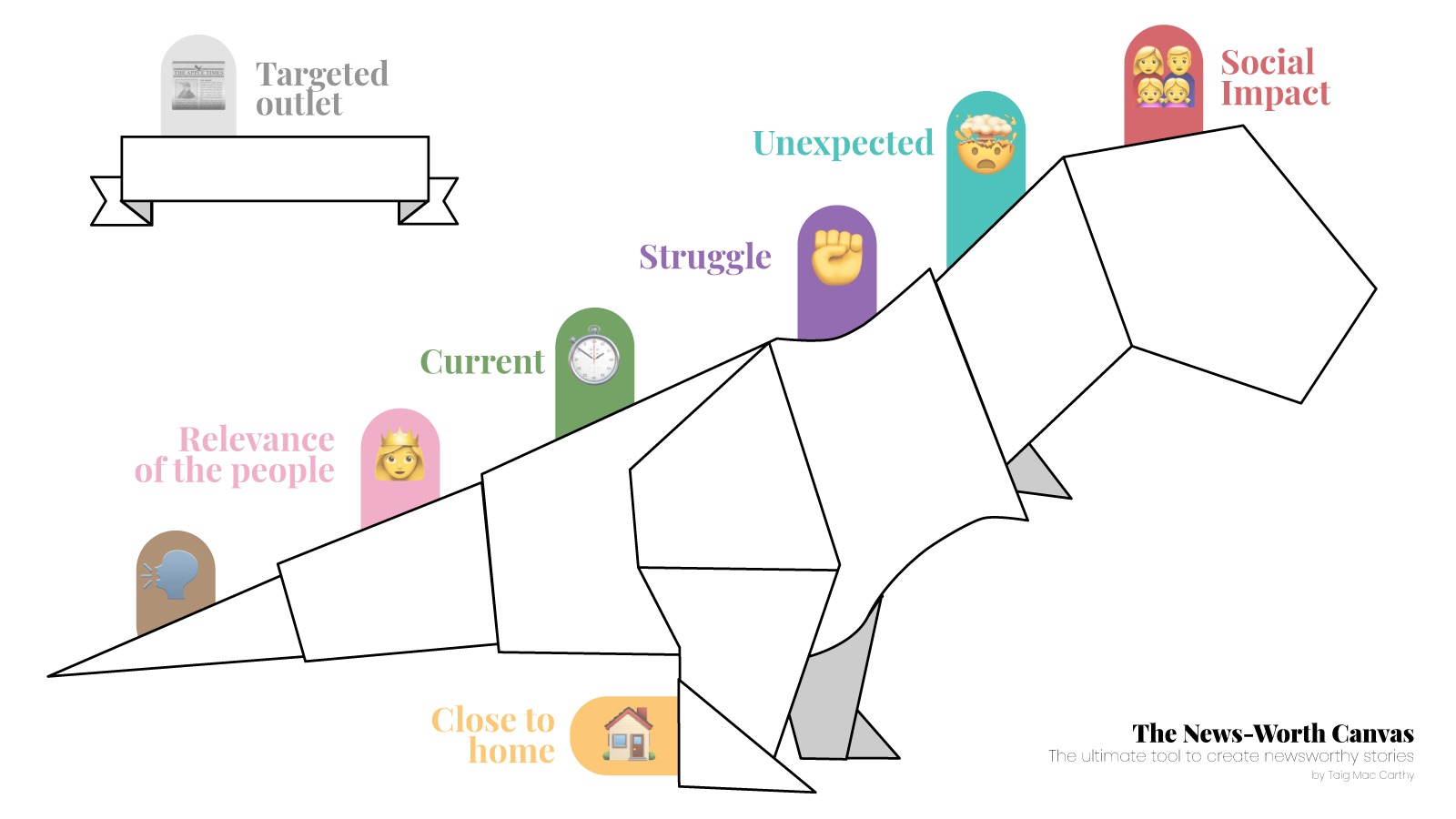
As well as a brainstorming tool, the canvas has become a shared language that allows a growing community of entrepreneurs and academics to easily describe and understand why a story is newsworthy. It is a great way of mapping out an idea, allowing it to be understood, tested and improved. In other words, the News-Worth Canvas is a tool to create stories and also to understand why stories are newsworthy, in a very visual and easy-to-understand way.
The News-Worth Canvas works best when printed out on a large surface so that groups of people can jointly start sketching and discussing newsworthy elements of a story with Post-it® notes or board markers. It is a hands-on tool that fosters understanding, discussion, creativity and analysis of stories.

News-Worth canvas in action
You can also use the canvas in a Google Slides format, if you are working remotely with your team.
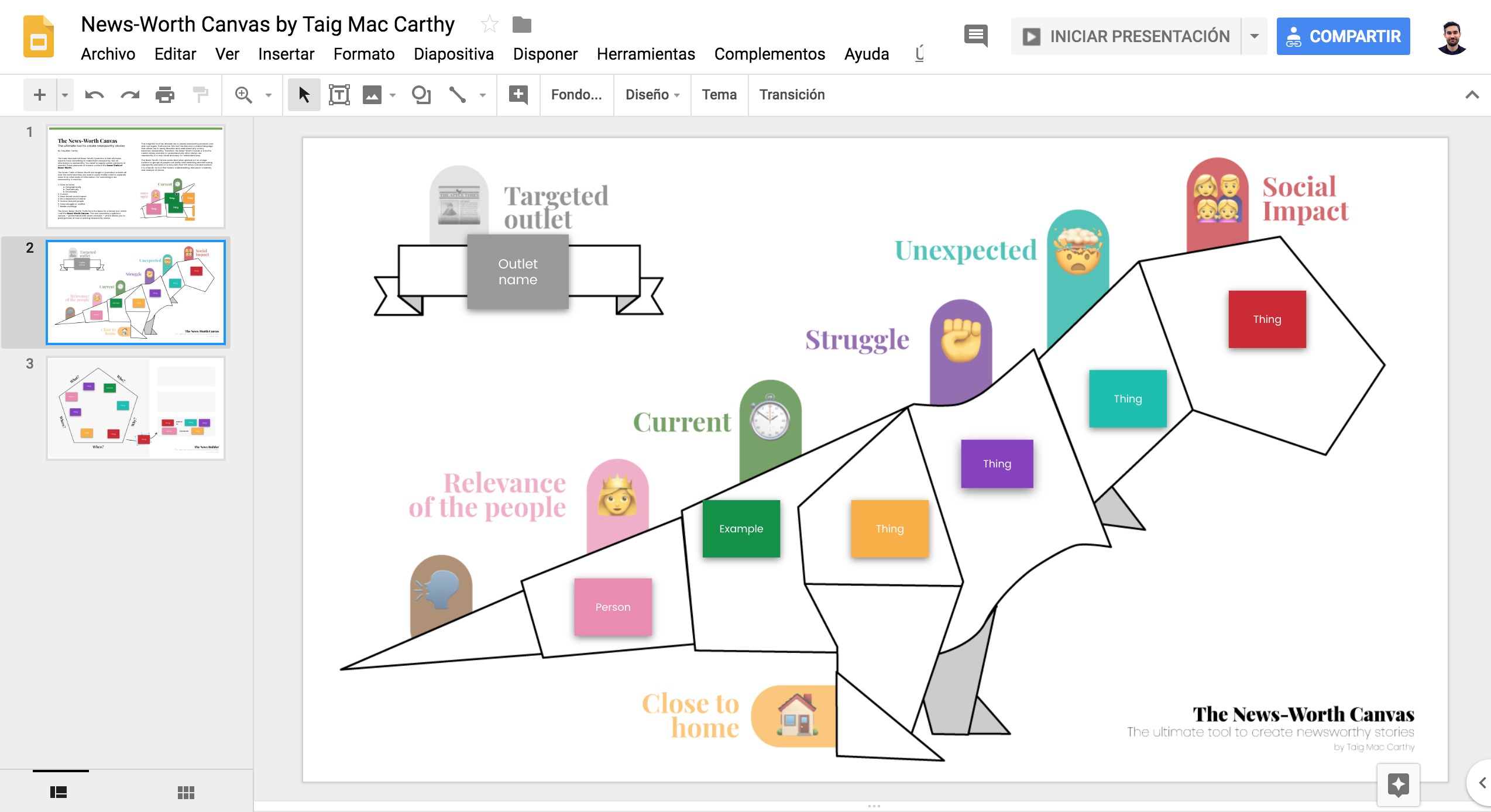
News-Worth Canvas template in Google Slides - https://bit.ly/newsworth-canvas-slides
Let's take a look at each module one by one.
The Seven traits of News-Worth
1. 🏠 Close to home
Dinosaurs happen in your neighborhood.
Closeness to home is the most basic trait of news-worth. Proximity is absolutely necessary if you want your company to be on the news, because the audience is only interested in stories that happen in their close environment. That is why I suggest you to start the exercise on this module.
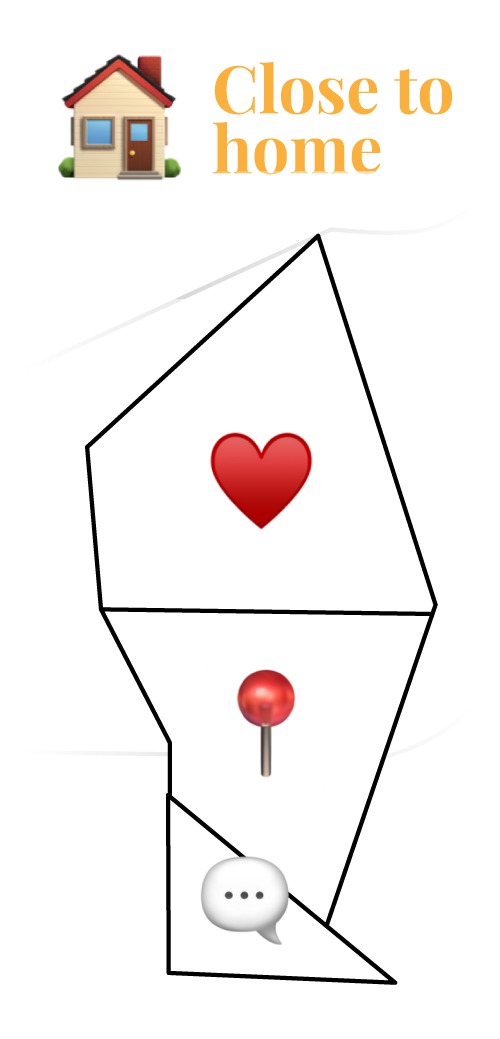
There are three ways of being close to home:
- 📍 Geographically close: applies to what is close physically speaking. For instance, something that takes place in the same town or city.
- ❤️ Thematically close: it concerns how the topic itself is relevant to the audience. For instance, a company doing blue wine would be more relevant to the French or Spanish audiences than the inhabitants of Iceland or Norway; just as American football would only be newsworthy in the US.
- 💬 Emotionally close: refers to what touches the audience morally or emotionally. For example, a terrorist attack in Europe would be very close to the US audience emotionally speaking.
Journalists care a lot about the proximity of the story, so you need to find a way to make your story close to the audience of the outlet. For example, if you want to appear in the newspaper Le Parisien, your story must be somehow relevant to people in Paris.
Even if you are a foreign entity, you must find a way to present yourself as a local initiative to appeal to the journalist of each region. This explains why the local newspaper of your hometown will always be more inclined to publish a story about your company: it's easy for you to be Close to Home when you are literally close to home. Otherwise, you must get creative and think of ways in which you can tackle a theme that is close to the audience or arouse an emotional response.
You will find an inventory of strategies for making your project close to home in the following pages. For now, keep in mind that if you find a way of making yourself close to home to every outlet, getting media coverage will be a piece of cake.
2. ⏱ Current
Dinosaurs are happening right now.
The story must be happening right now, otherwise it will not be newsworthy. Something is newsworthy while it happens, even if it was foreseeable. The past is not newsworthy. The future is rarely newsworthy. The event has to be timely. This is a determining element to differentiate news from noise.

The time in which the story happens is usually implied in the verb of the heading, rather than being explicitly mentioned. So this is how you should write your headline:
✔️ Company just launched a product today
And never:
❌ Company will launch a product next week
❌ Company launched a product earlier this month
It is essential to find a way of making your project current, otherwise you will not be able to get your project into the news. This explains why traditional, long-established companies have to pay so much for advertising in media outlets, and newcomers seem to get coverage more easily — their novelty makes them seem more current. But even if you are a novel startup, you must find a way to present yourself as something happening at this moment.
This also why media coverage is difficult when you try to promote in advance a conference , a party or an event in advance. When promoting an event, you need people to be aware many days before the date. The problem is that journalists will not publish an article about something until it's already happening. So you must either pull off some kind of stunt prior to the event, or simply pay for advertising.
You will find tricks to make your project current in the following pages. For now, simply remember that you must be as current as possible to amplify the news-worth of your project.
3. 👨👩👧👦 Broad Impact
Dinosaurs affect a lot of people.
Having a broad impact makes a story automatically remarkable. As a matter of fact, journalists will publish anything that affects a lot of people, even if it's not that amazing — and the more people involved, the more newsworthy the story will be.
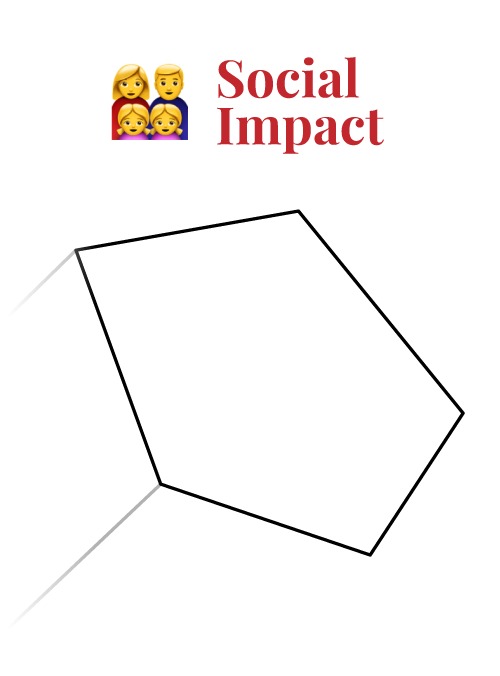
This is also why journalists tend to focus on bad things, like terrorist attacks or natural disasters — because they affect a lot of people. It sounds grim, but that is their job and it's very valuable to society. Yes, there is an element of morbid fascination, but that says more about society than about journalists.
Everyday issues such as Health, Transport or National Security have an impact on a large population and generate much public interest. This is why mainstream media sometimes publishes articles about rises in income tax -even though it's a dull topic- since it affects many people's pockets.
This trait is heavily dependent on the audience of the outlet that you are targeting. If you are targeting a mainstream outlet, your story must impact a very broad audience — as close to everyone as possible. On the contrary, if you are targeting a local outlet, or one that focuses on a specific topic (technology, gardening, law practice…) you can narrow it down to that audience.
When considering what has a broad impact, keep in mind that in mass media you need to appeal to normal people with normal lives and who care about everyday normal stuff, not investors or experts in your field. I usually consult my projects with my mother, because she is very straightforward about not being interested in the technical intricacies of my work.
To sum up: when coming up with a story, bear in mind the impact that your project has over the audience and try to make it as widespread as possible. You will find ideas to amplify the impact of your project in the next section of this book.
4. 🤯 Unexpected or bizarre
<p>**Dinosaurs are surprising.**</p><p>Journalists are very interested in stories that catch their audience's attention. It is that simple. Therefore, if a story has some element of surprise or something bizarre, it is more likely to be published.</p><p><img src="https://whereisthedinosaur.com/wp-content/uploads/2018/12/news-worth-canvas-neck-unexpected-01.jpg" alt=""></p><p>This is why you often read articles about snow in September or grandmothers turning 100-years-old. These stories are an infraction or a deviation from the normal course of things and therefore become newsworthy.</p><p>Discoveries are also surprising. For instance, journalists often publish the results of scientific studies if the results are somehow surprising — in some cases regardless of their accuracy. This also explains why Donald Trump or Kanye West keep gaining influence by saying outrageous things. Every time they do something crazy, they generate unexpected and bizarre stories that the audience loves reading and journalists love covering.</p><p>If you find a way of making yourself unexpected or bizarre, then getting media coverage will be way easier for you. I have some great examples for you in the following pages.</p>
Get the full book
News-Worth Creation
Access premium content
- Full version of the content
- Bonus resources: templates, tips...
5. 👸 Relevance of the people involved
<p>**Dinosaurs implicate influential people.**</p><p>Journalists follow leaders of opinion. This trait is so important that a quote alone can turn something into a newsworthy story; if the person quoted is a relevant enough.</p><p><img src="https://whereisthedinosaur.com/wp-content/uploads/2018/12/news-worth-canvas-tail-relevanceofthepeopleinvolved-01.jpg" alt=""></p><p>Leaders of opinion can be of three types:</p><ul><li>**Public figures**such as the UN Boss or the CEO of a company. People might not know the identity of the person, but they know the stand they speak from or their title.</li><li>**Institutions**such as governmental branches or foundations, who often give awards. It could also be a hospital, a research center, an statistic observatory… any institution that is understood to be a leader of opinion will be considered relevant.</li><li>**Celebrities**such as Kim Kardashian or Donald Trump.</li></ul><p>When a startup develops a gadget, it may not be newsworthy. But if a renowned doctor or a celebrity praises it, the quote alone can turn it into a newsworthy event.</p><p>For instance, take a look at this stories:</p><p><a href="https://thehill.com/policy/technology/410890-tim-cook-says-apple-will-donate-to-hurricane-michael-relief">Apple CEO Tim Cook**says**company will donate to Hurricane Michael relief</a></p><p><a href="https://www.theguardian.com/world/2018/sep/24/deadly-yemen-famine-could-strike-at-any-time-warns-un-boss">Deadly Yemen famine could strike at any time,**warns**UN boss</a></p><p>In both cases, the story is that someone says something, rather than the thing itself; because people known by the public are often news, more so than whatever is actually happening.</p><p>The same goes for awards: if an institution thinks that your product is important, a journalist might take their word for it and publish a story about it.</p><p>For example:</p><p><a href="https://www.usatoday.com/story/news/2017/11/16/unique-ghana-college-wins-500-000-award/871153001">Unique Ghana college**wins $500,000 award.**USA TODAY</a></p><p><a href="ttps://www.nytimes.com/2018/06/05/style/cfda-winners.html">Fashion**Gives Its Top Award**to a Man Who Says He Isn't a Designer. 2018/06/05. New York Times</a></p><p><a href="https://www.nytimes.com/2018/05/31/theater/parkland-drama-teacher-melody-herzfeld-tony-award.html">Parkland Drama Teacher**Will Receive Tonys' Education Award.**2018/05/31. New York Times</a></p><p><a href="https://www.nytimes.com/2018/04/18/arts/music/anti-semitism-german-rap.html">Fury in Germany as Rap Duo With Anti-Jewish Lyrics**Gets Award.**2018/04/18. New York Times</a></p><p><a href="https://www.nytimes.com/2018/04/25/lens/sim-chi-yin-a-patient-photographer-wins-chris-hondros-award.html">Sim Chi Yin, a Patient Photographer,**Wins Chris Hondros Award.**2018/04/25. New York Times</a></p><p>In all these cases, the award itself is the story, rather than the person or the company receiving the award.</p><p>The most extravagant way of achieving this is celebrity involvement. If you get Trump to criticize you or Ashton Kutcher to be an investor, that makes it newsworthy simply because the people involved are known to the audience.</p><p>Keep this in mind when crafting your story and try to implicate famous or notorious people or institutions in order to make it more remarkable.</p>
Get the full book
News-Worth Creation
Access premium content
- Full version of the content
- Bonus resources: templates, tips...
6. ✊ Struggle or conflict
<p>**Dinosaurs cause agitation.**</p><p>The struggle between parties is a great element of interest. Something that would normally not be newsworthy can instantly become newsworthy if there is conflict involved.</p><p><img src="https://whereisthedinosaur.com/wp-content/uploads/2018/12/news-worth-canvas-chest-struggle-01.jpg" alt=""></p><p>This is true for news stories as much as any other kind of story. Imagine a movie in which the boy and the girl fall in love and everything goes fine and everybody is happy and they have a child and nothing bad happens. No one will pay to watch such a movie. We all want drama, turmoil, tragedy and tension.</p><p>The most newsworthy stories are those that arouse both love and hate from different sectors of society. Entrepreneurs often try to please everyone and try to avoid people hating them. This is a bad strategy from the news-worth dynamics point of view. If the story is newsworthy, it's very likely — and certainly desirable — that someone will feel strongly against it.</p><p>For instance, in a “David vs. Goliath” situation, some people will get excited and support the new contender as they defy the status quo. However, people belonging to the status quo will not support the new contestant, and therefore there will be a clash of opinions, which means that some people will be against it. It is inevitable.</p><p>Please remember that this is good for you. In fact, people who hate something tend to talk about it even more than those who support it. Therefore, when thinking about your story don't be afraid of drama. Conflict works as a fuel for interest and makes your story more newsworthy, as you will learn in the examples set out in the following pages.</p>
Get the full book
News-Worth Creation
Access premium content
- Full version of the content
- Bonus resources: templates, tips...
7. 🗣 Previous media coverage
Dinosaurs appear in the news.
Generally- speaking, people assume that something is newsworthy once it has been covered by media outlets — even if it's not really that interesting.
This is why it is so much easier to get into a big outlet once you have appeared in a smaller one. In one of my first startups I tried to get into nationwide TV news with no success — until one day, someone called me from the largest news channel asking for an interview. I later found out that they became interested in the story after reading an article about the project in a smaller newspaper.
Also, remember that news outlets compete against each other for the best stories, both in quantity and quality, but specially in speed. So a good way of getting an editor or a reporter interested in your story is letting them now that another channel or newspaper is interested too.
So try getting into a smaller outlet first to get validation that will add up to the news-worth of the story.
TIPS
Team up
Don't dinosaur by yourself. This is not how human brains work. Specially when working with the News-Worth Canvas, because it is supposed to be fun. Think of it as a game rather than a marketing exercise and don't be afraid of making jokes or saying crazy stuff. Some of the best ideas start as a joke.
It is very important that you use the canvas along with other people: either your co-founders, your friends or even your relatives. Anyone that helps you have fun in the process will improve the outcome dramatically. That is why we strongly advise you to team up.
As we have mentioned already, the canvas works best when printed out on a large surface so that groups of people can jointly start sketching and discussing newsworthy elements of a story. You can also use the canvas in a Google Slides format, if you are working remotely with a team that is in different locations.
Start by picking one media outlet
When filling up the News-Worth Canvas, the first task you must complete is choosing the outlet you will be targeting. It is vital to have a single outlet in mind during the whole exercise, because many of the traits depend on what media outlet you want to appear in.
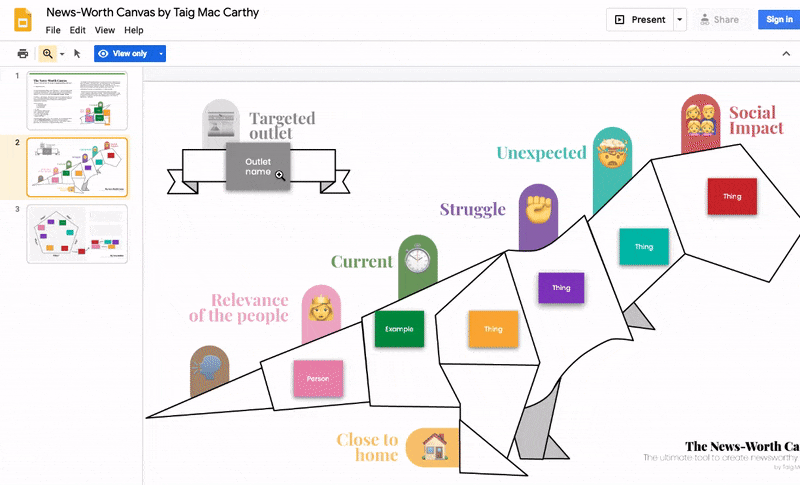
It should be self-explanatory, but in order to make a story Close to Home, you must first settle on a location to call home. If you are targeting USA Today, the story must be somehow close to the whole US nation. However, if you are targeting The Improper Bostonian, you should make it close to the Boston area specifically. Likewise, if you want the story to have a Broad Impact over the audience, you must define what the audience is. Impacting the audience of a niche magazine that is focused on a single topic, like Law Practice or Fishing, requires a very different approach to impacting a nation-wide newspaper.
So picking an outlet in advance is key when working with the News-Worthy Canvas. That is why we strongly advise you to start by picking one media outlet before moving on the dinosaur.
Think like a journalist
When filling up the News-Worth Canvas, make the effort of imagining that you are a journalist and that you have nothing to do with your own project. This trick will help you keep in mind that the story is not about you, but rather about an event in which your company is casually involved.
Journalists have one thing in mind: creating stories. While entrepreneurs are selling products and influencers promote themselves, journalists want to sell stories. And their main job is to create stories that are catchy and appealing, just as entrepreneurs are focused on creating products that are desirable and appealing.
Stories and products are very different. Entrepreneurs are usually focused on creating value for their customer and offering solutions to their problems — which is usually a good thing. However, journalists do not think that way. Journalists are focused on getting people's attention and creating stories that people will share and talk about. And so should you when working with the News-Worth Canvas.
What will happen if you fail to think like a journalist? To begin with, your press release will feel like advertising, and therefore it will not be published unless you pay. And on the other hand, your creativity will be limited to either describing your product or praising it, instead of coming up with out-of-the-box ideas such as stories in which your company is not the main element, or events in which there is some ugly stuff going on.
Even if some of the ideas talk bad about your product, remember that it is not necessarily a bad thing. You should come up with all sorts of ideas, regardless of how you feel about them, because that's what a journalists does. That is why we strongly advise you to think like a journalist.
